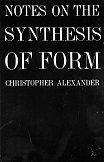
Christopher Alexander's marvellous Timeless Way series lays out a philosophy of building design, a Pattern Language method to achieve the Timeless Way style, and show how these were used in planning at the University of Oregon.
The ideas, although originally expounded for (physical) architectural design, have recently been picked up by the Object Oriented computing community for OO Pattern Languages.
The philosophy itself is also deliciously socially subversive, since it would require radical changes in working patterns, transportation policy, and educational policy, at the very least, to work on the larger scale.
Now, at last, here is a coherent theory which describes in modern terms an architecture as ancient as human society itself.
The Timeless Way of Building is the introductory volume in the Center for Environmental Structure series. Christopher Alexander presents in it a new theory of architecture, building, and planning which has at its core that age-old process by which the people of a society have always pulled the order of their world from their own being.
Alexander writes, “There is one timeless way of building. It is thousands of years old, and the same today as it has always been. The great traditional buildings of the past, the villages and tents and temples in which man feels at home, have always been made by people who were very close to the center of this way. And as you will see, this way will lead anyone who looks for it to buildings which are themselves as ancient in their form as the trees and hills, and as our faces are.”
Volume 1 lays out the philosophy of The Timeless Way, with numerous illustrative examples. The essence is that the people who are to live in the buildings should be closely involved in the design, and that buildings should grow naturally, rather than be planned. It talks about desirable patterns – common features abstracted from many successful buildings – and about a pattern language for describing and combining these patterns.
After a ten-year silence, Christopher Alexander and his colleagues at the Center for Environmental Structure are now publishing a major statement in the form of three books which will, in their words, “lay the basis for an entirely new approach to architecture, building and planning, which will we hope replace existing ideas and practices entirely.” The three books, The Timeless Way of Building, The Oregon Experiment, and this book, A Pattern Language, are described on the back cover.
At the core of these books is the idea that people should design for themselves their own houses, streets, and communities. This idea may be radical (it implies a radical transformation of the architectural profession) but it comes simply from the observation that most of the wonderful places of the world were not made by architects but by the people.
At the core of the books too is the point that in designing their environments people always rely on certain “languages,” which, like the languages we speak, allow them to articulate and communicate an infinite variety of designs within a formal system which gives them coherence.
This book provides a language of this kind. It will enable a person to make a design for almost any kind of building, or any part of the built environment.
“Patterns,” the units of this language, are answers to design problems (How high should a window sill be? How many stories should a building have? How much space in a neighborhood should be devoted to grass and trees?). More than 250 of the patterns in this pattern language are given: each consists of a problem statement, a discussion of the problem with an illustration, and a solution. As the authors say in their introduction, many of the patterns are archetypal, so deeply rooted in the nature of things that it seems likely that they will be a part of human nature, and human action, as much in five hundred years as they are today.
Volume 2, the core of the method, provides a language of 253 patterns, for describing buildings, and how they should be designed. The patterns range over ones for whole towns: ‘mosaic of subcultures’, ‘four-storey limit’, ‘local transport areas’ – ones for small clusters of buildings: ‘small public squares’, ‘common land’, ‘individually owned shops’ – ones for individual buildings: ‘site repair’, ‘entrance transition’, ‘sheltering roof’, ‘light on two sides of every room’ – and ones for small parts of the construction: ‘alcoves’, ‘ceiling height variety’, ‘thick walls’.
1999: We are having a house built to our own design. Remembering the lessons of A Pattern Language, I explicitly used the pattern ‘light on two sides of every room’, by designing in some extra windows – I hope it works!
Volume 3 describes how the Timeless philosophy and Pattern Language method was applied to planning for the University of Oregon. It explains the process of piecemeal growth, speading resources evenly and encouraging repair, and contrasts it with the more popular, but potentially disasterous, lump development, which concentrates resources in a few large developments, and correspondingly large mistakes.